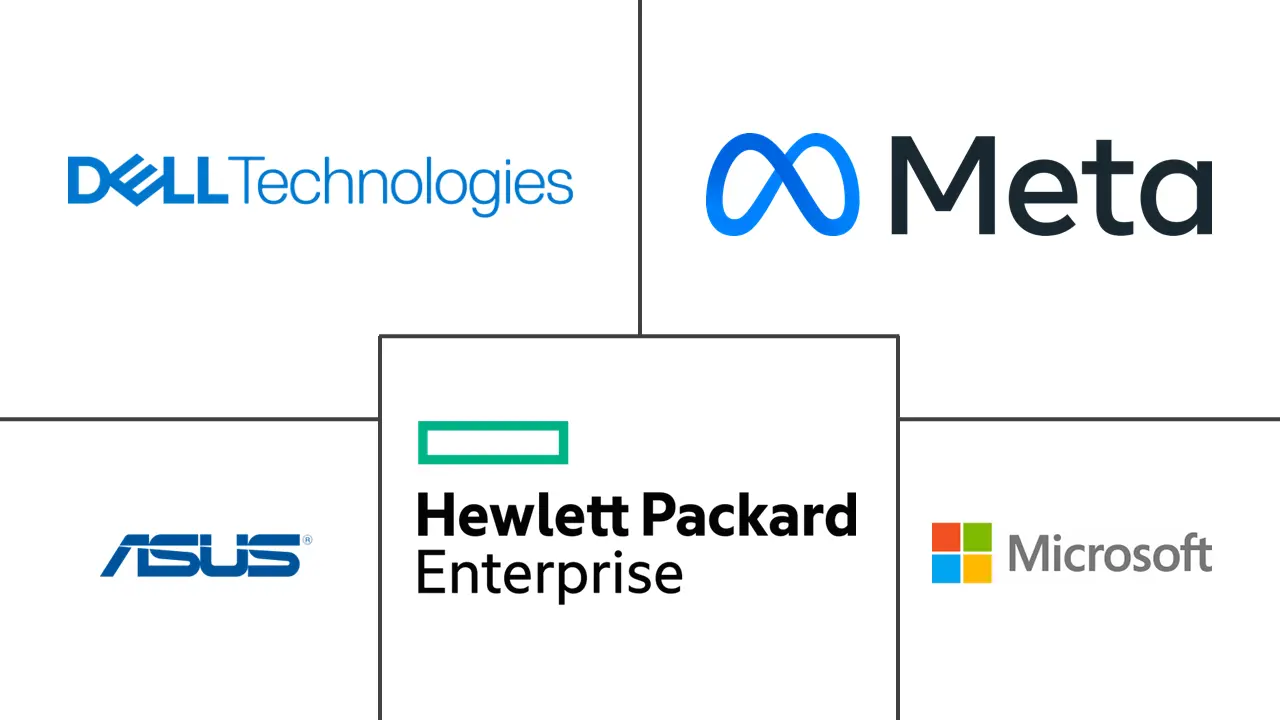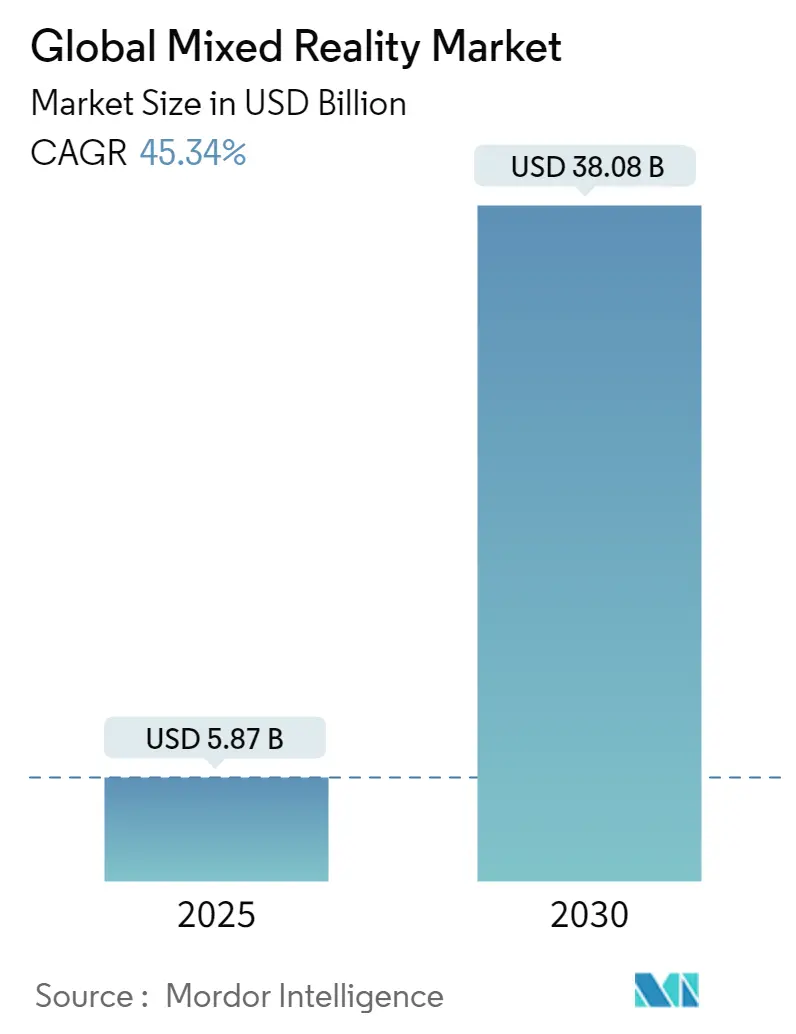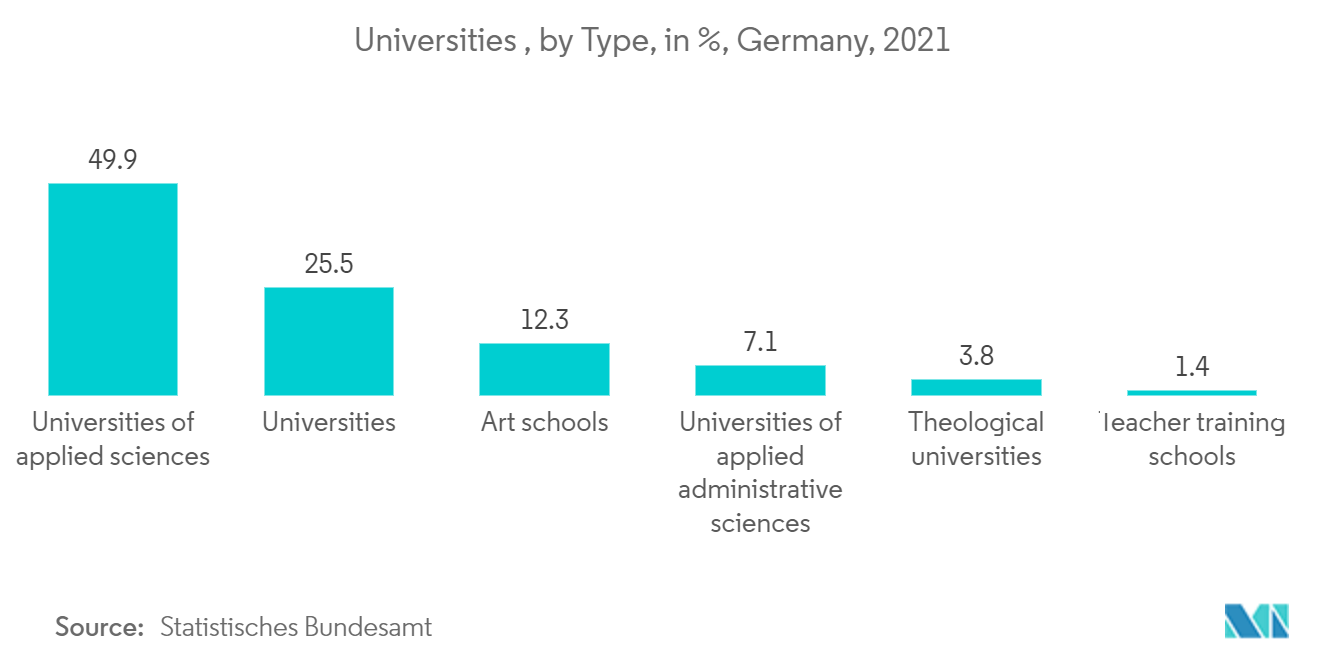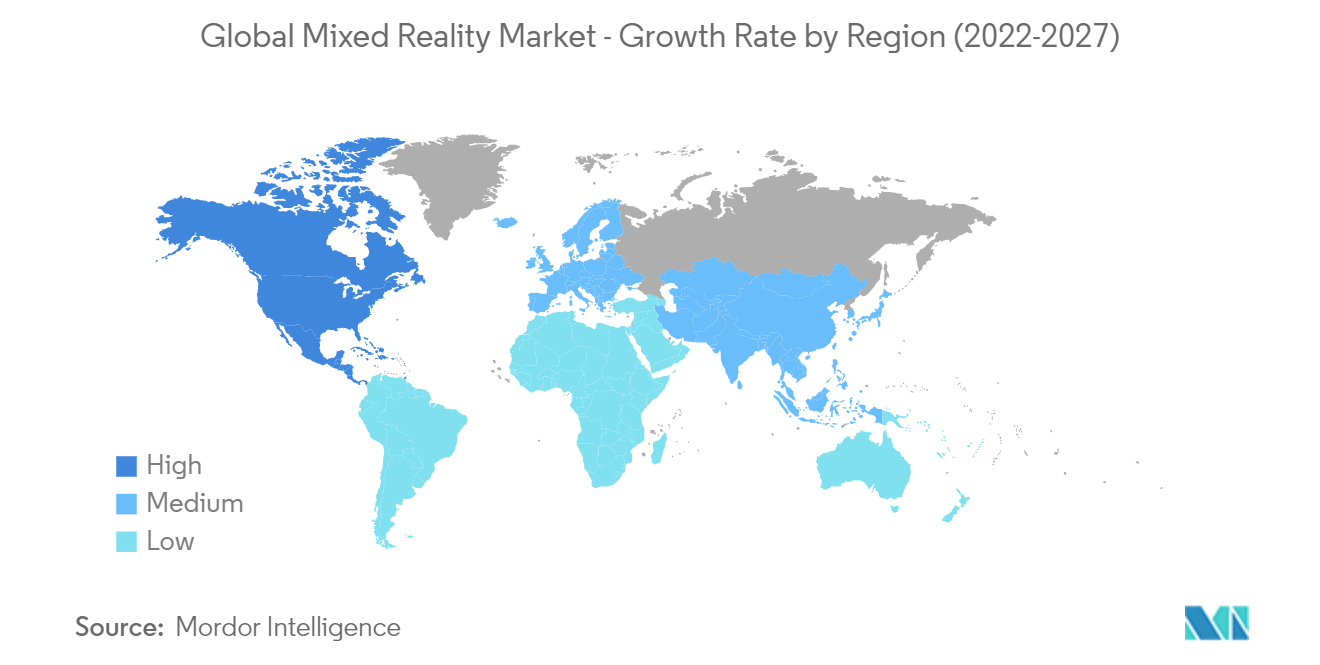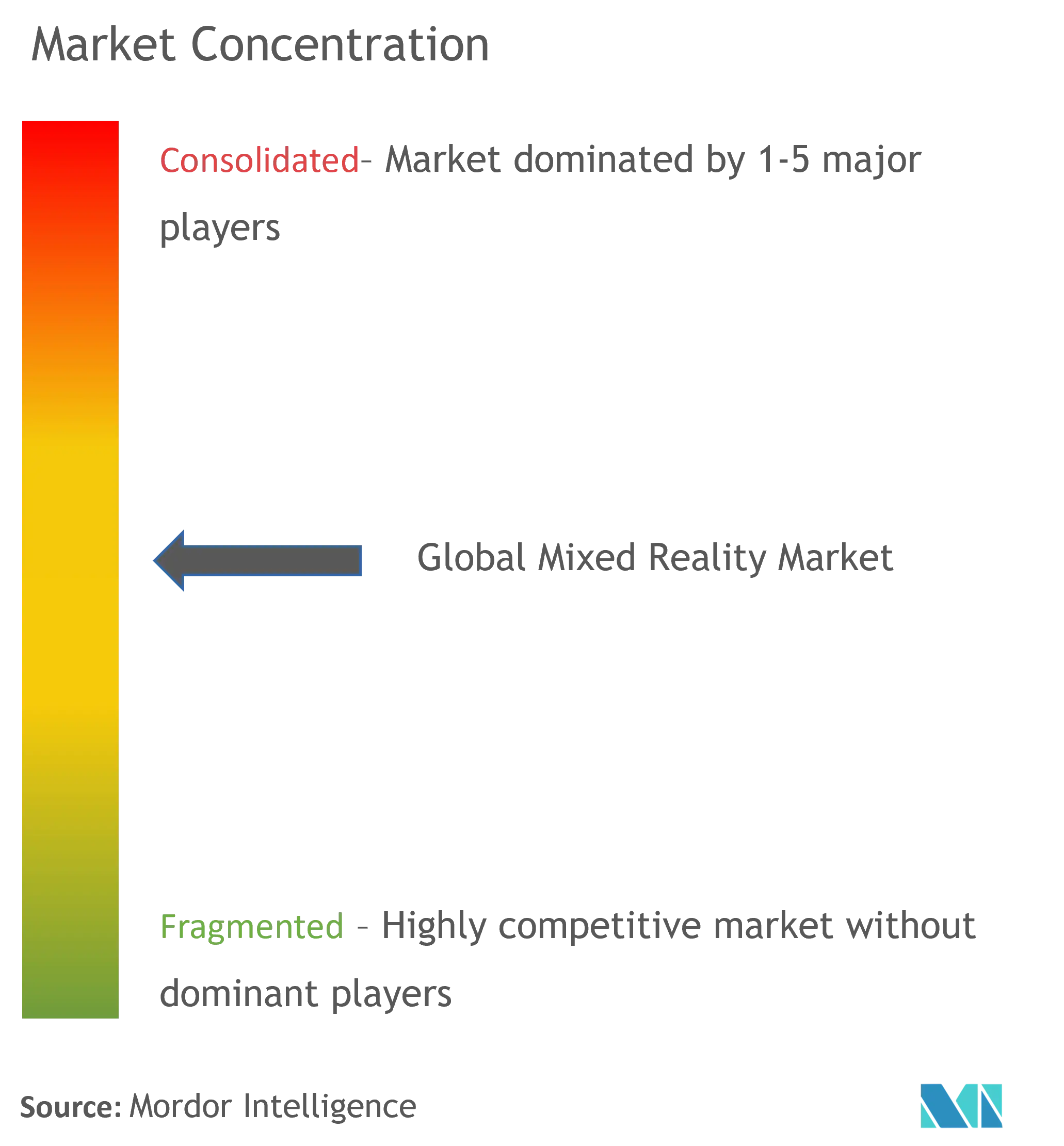Mixed Reality Market Size
Mixed Reality Market Analysis
The Global Mixed Reality Market size is estimated at USD 5.87 billion in 2025, and is expected to reach USD 38.08 billion by 2030, at a CAGR of 45.34% during the forecast period (2025-2030).
Mixed reality (MR) is becoming increasingly well-known in business processes, and this trend is only anticipated to continue. Initial costs, though, have been at higher price points, making it difficult for consumers to afford them, but they are still rather cheap for businesses. By overlaying information on top of the real environment, MR devices can significantly boost people's knowledge of their surroundings for businesses. Allowing distant workers to see the work accurately in real-time so they can give greater input can enhance teamwork. Successful MR material for the entertainment industry needs to elicit an emotional response from the viewer.
- The increasing usage of mixed reality technologies in the global educational sectors is one of the primary factors driving the expansion of the mixed reality market share. Because it enables us to make things more interactive, the technology developed by the mixed reality industry is advantageous for both students and teachers. Additionally, it can be used by instructors to teach different students without requiring the importance of being at a specific location. Additionally, the mixed reality industry ensures that study methods improve and become more engaging. Additionally, using a variety of 3D images helps to reduce learning mistakes. This novel approach fuels the growing demand for mixed reality devices made by the education sector.
- The Food and Drug Administration (FDA) has approved multiple surgical planning apps for Microsoft's Hololens mixed reality headset. Companies, such as Gaumard, collaborated with Microsoft for the future of simulation-enhanced healthcare learning. In May 2021, A new mixed reality (MR) training program called "Obstetric MR" for "VICTORIA" was unveiled by Gaumard Scientific Co. Its goal is to support students to become clinically competent in delivery procedures more quickly and effectively. The Obstetric MR system comprises a HoloLens 2 device preloaded with new software for the VICTORIA S2200 maternal and neonatal care model patient, packed full of sensors and is used as a childbirth training tool for medical schools, nursing schools, and hospitals worldwide.
- Adopting mixed reality is picking up steam in several industries where having information at eye level is an advantage. Microsoft is increasingly emphasizing improving its products to broaden the scope of its application space. For instance, in March 2021, Microsoft was awarded a USD 21.9 billion contract by the US Army to manufacture HoloLens 2 headgear. Such improvements are also anticipated to impact how other end-user sectors adopt the technology.
- Physical lockdowns across the major regions may act positively on the MR technology demand. Enterprises worldwide are trying to get their internal and wider geographically spread teams to communicate, collaborate, and find a path forward during the crisis. The diverse potential of XR application in recreating the tourism experience allows multi-stakeholders to overcome the travel restrictions and lockdown, allowing the crisis to act as an accelerator of the existing trends for XR adoption. Medical professionals using mixed reality headsets to treat coronavirus-infected patients. Using hand gestures, clinicians using Microsoft devices can speak with coworkers in a separate, virus-free room while viewing x-rays, scans, and test results. The requirement for PPE has decreased due to technology.
- Mixed reality devices are also prone to risks since all the IoT devices interact with the Internet (i.e., the Internet is an unsecured network). The vulnerabilities exploited can be defined as risks. Moreover, preserving the data's confidentiality, integrity, and availability are data security and privacy concerns. In each state, this data could get vulnerable to cyberattacks. These cyberattacks could take a mode of computer-aided attack or a computer-targeted attack. Considering the risks of mixed reality systems requires analyzing them from two perspectives; the perspective of IoT architecture and the MR system.
Mixed Reality Market Trends
Education Sector will Hold a Significant Market Share
- With the use of Mixed Reality, classroom education can be interactive as MR can enable teachers to show virtual examples of concepts and add gaming elements to support textbooks. This will allow students to learn faster and memorize more information. The number of students experiencing difficulties concentrating and staying focused while learning is constantly rising. Admissionly shows that at universities and colleges, students face difficulties while focusing. Moreover, they face other mental health issues, like depression and anxiety.
- Microsoft stated that there is a 22% improvement in test scores among students using immersive technology and a 35% increase in student engagement and retention when learning with immersive and 3D technologies through mixed reality. Microsoft's HoloLens 2 offers several mixed reality apps, such as Fragments, RoboRaid, and ZARZL, and is more targeted at businesses and the education sector.
- Even at a much younger age, statistics show students experiencing difficulties in staying focused, with the Center for Disease Control and Prevention reporting that the diagnoses of ADHD among K-12 schoolers are continuing to rise, with over 5.7 million children currently diagnosed. In such scenarios, using MR technology during classes enables students to concentrate on literally what is in front of their eyes. In a way, they are forced to interact with their study mates and exclude any potential side stimuli. Furthermore, According to Statistisches Bundesamt, in the winter semester of 2021/2022, the share of universities of applied sciences in Germany was 50%.
- In May 2022, The Immersive Learning Research Program (ILRP), one of the largest research programs to date in immersive education, has attracted the participation of over 20 further and higher education institutions from the US, UK, EU, and Canada, according to Bodyswaps, a provider of immersive learning software that enables learners to practice soft skills in virtual reality (VR) with AI-enabled analytical feedback.
- In June 2022, A partnership between Microsoft and Maharashtra University of Health Sciences, Nashik, was announced for digital innovation and collaboration in healthcare services and medical education. The two institutions will collaborate on projects utilizing advanced medical technology, such as tech-driven remote healthcare solutions, mixed reality patient care, and medical education and training.
North America Holds the Major Share of the Market
- With many players in the North American region, the mixed reality market is expected to grow significantly in the forecast period. Also, these companies are investing extensively in product innovations and strategic partnerships. For instance, in May 2021, CAE USA was selected for a prototype project to develop an HH-60W virtual/mixed reality aircrew trainer.
- Additionally, Canada-based Arvizio introduced version 2.0 of its Mixed Reality (MR) studio, an enterprise-level solution designed to provide multi-user and multi-site mixed reality experiences. The company announced the integration of its MR Studio with Autodesk BIM 360 and A360 applications to leverage the Forge API to convert seamlessly and import models created with design tools on Magic Leap, Microsoft HoloLens, mobile AR devices, and virtual reality headsets.
- In February 2021, Microsoft launched HoloLens 2, specially designed for industrial applications. CAE Inc., a Canadian manufacturer of simulation technologies, opted for Microsoft HoloLens for its subsidiary CAR Healthcare to deliver training solutions for up to 11 learners simultaneously by using mixing reality technology.
- According to Statistics Canada and World Bank, 12.31% and 16.63% of Canada and the United States population will be 65 or above in 2020. Also, Rockwell Automation mentioned that over 25% of its workforce are 55 years or above, and their jobs are not actively pursued by the younger generation, creating a skill gap. This gap can be filled by using mixed reality headsets to train safely in a digital environment.
- The North American region is one of the highest spenders on its military and defense. The United States, which spends around USD 14 billion a year in digital training of the Army, with a prime focus on military innovation, collaborated with Microsoft for its MR headsets HoloLens, to enable the Army to detect enemies while on the battlefield. Also, in 2021, Microsoft was awarded over USD 20.8 billion worth of US Army contracts for its Hololens.
Mixed Reality Industry Overview
The global mixed reality market is moderately consolidated, with the presence of a few major companies. The companies are continuously investing in making strategic partnerships and product developments to gain more market share. Some of the recent developments in the market are:
- April 2022 - As a licensed partner of Microsoft's Mixed Reality Capture Studios, Nikon has established a wholly-owned subsidiary called Nikon Creates Corporation that will provide the ability to plan, shoot, and generate volumetric, virtual reality (VR), and 3D content. Through the use of computer graphics, either through the use of a huge monitor or a green screen, the new production center will provide the capability to both capture and synthesize the movement of individuals against a background.
- May 2022 - Microsoft India will work with the All-India Institute of Medical Sciences (AIIMS), Jodhpur. At AIIMS, Jodhpur, the two institutions will create a Mixed Reality Center of Excellence that will offer healthcare, improve remote healthcare capabilities, and promote educational possibilities for both staff and students.
Mixed Reality Market Leaders
-
Microsoft Corporation
-
Meta Platform Inc
-
Hewlett Packard Enterprise
-
Dell Technologies IncDe
-
Asus Tek Computer Inc
- *Disclaimer: Major Players sorted in no particular order
Mixed Reality Market News
August 2022 - Siemens and TeamViewer are collaborating on augmented and mixed reality (AR/MR) solutions for product lifecycle management. The companies have established a "strategic relationship" to combine the advantages of Siemens Teamcenter product lifecycle management with TeamViewer's enterprise augmented reality platform, Frontline.
May 2022 - In order to create intelligent Extended Reality (XR) solutions for business and engineering applications, Tata Elxsi and Lenovo have partnered. Through this agreement, the two businesses hope to provide clients using Lenovo's smart XR devices in both large and small office settings as well as industrial settings with end-to-end solutions and services. Augmented reality (AR), virtual reality (VR), mixed reality, and everything in between is all included under the umbrella term "XR."
Mixed Reality Industry Segmentation
Mixed reality combines the aspects of the virtual world with those of the real world. It enables users to interact with two worlds. The scope of the study focuses on a global market analysis of Mixed reality products. Market sizing encompasses the revenue generated through mixed reality products across the globe sold by various market players. The study also tracks the key market parameters, underlying growth influencers, and major vendors operating in the industry, which supports the market estimations and growth rates over the forecast period. The study further analyzes the overall impact of Covid-19 on the ecosystem. The report's scope encompasses market sizing and forecast for end-user verticals and geography.
The Global Mixed Reality Market is segmented by End-user Verticals (Education, Engineering, Entertainment, Healthcare) and by Geography.
| End-user Verticals | Education | ||
| Engineering | |||
| Entertainment | |||
| Healthcare | |||
| Other End-user Verticals | |||
| Geography | North America | United States | |
| Canada | |||
| Europe | United Kingdom | ||
| France | |||
| Rest of Europe | |||
| Asia-Pacific | China | ||
| India | |||
| Japan | |||
| Rest of Asia-Pacific | |||
| Rest of the World | |||
| Education |
| Engineering |
| Entertainment |
| Healthcare |
| Other End-user Verticals |
| North America | United States |
| Canada | |
| Europe | United Kingdom |
| France | |
| Rest of Europe | |
| Asia-Pacific | China |
| India | |
| Japan | |
| Rest of Asia-Pacific | |
| Rest of the World |
Mixed Reality Market Research FAQs
How big is the Global Mixed Reality Market?
The Global Mixed Reality Market size is expected to reach USD 5.87 billion in 2025 and grow at a CAGR of 45.34% to reach USD 38.08 billion by 2030.
What is the current Global Mixed Reality Market size?
In 2025, the Global Mixed Reality Market size is expected to reach USD 5.87 billion.
Who are the key players in Global Mixed Reality Market?
Microsoft Corporation, Meta Platform Inc, Hewlett Packard Enterprise, Dell Technologies IncDe and Asus Tek Computer Inc are the major companies operating in the Global Mixed Reality Market.
Which is the fastest growing region in Global Mixed Reality Market?
Asia Pacific is estimated to grow at the highest CAGR over the forecast period (2025-2030).
Which region has the biggest share in Global Mixed Reality Market?
In 2025, the North America accounts for the largest market share in Global Mixed Reality Market.
What years does this Global Mixed Reality Market cover, and what was the market size in 2024?
In 2024, the Global Mixed Reality Market size was estimated at USD 3.21 billion. The report covers the Global Mixed Reality Market historical market size for years: 2019, 2020, 2021, 2022, 2023 and 2024. The report also forecasts the Global Mixed Reality Market size for years: 2025, 2026, 2027, 2028, 2029 and 2030.
Our Best Selling Reports
Mixed Reality Software Industry Report
The mixed reality market is undergoing a significant transformation, with mixed reality technology being integrated across various sectors, revolutionizing industries like entertainment, education, healthcare, and more. This technology blends the real world with computer-generated elements, enhancing immersive experiences and creating lucrative opportunities, especially within the software segment. Advances in game engines, 3D modeling, and Augmented Reality (AR)/ Virtual Reality (VR) development platforms are driving the demand for wireless devices, essential for immersive mixed reality experiences. The global mixed reality landscape is continuously evolving, due to technological innovations such as Artificial Intelligence (AI) and machine learning (ML), which enhance user interactions and expand the application range of mixed reality solutions. Despite facing challenges like a shortage of skilled professionals, the mixed reality market is set for substantial growth, opening new avenues for interactive design and immersive content creation. For detailed insights, Mordor Intelligence™ Industry Reports offer a comprehensive analysis of the Mixed Reality Software market, including market share, size, revenue growth rate, and a forecast outlook, available as a free report PDF download.

